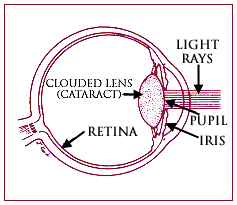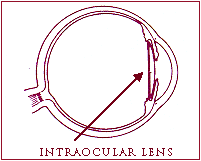What is a cataract?
 A cataract is a clouding of the eye's
natural lens. Depending on the degree of cloudiness, a cataract can cause a
little blurring or severe loss of vision. The rate at which a cataract
progresses is highly variable. It is not a tumor or a growth. It is not
a film over the eye that can be peeled away. Vision can only be restored by
surgical removal of the cataract. One out of every fifty people will find it
necessary to have this cloudy lens removed. Approximately 1,000,000 cataract
operations are done each year in the United States.
A cataract is a clouding of the eye's
natural lens. Depending on the degree of cloudiness, a cataract can cause a
little blurring or severe loss of vision. The rate at which a cataract
progresses is highly variable. It is not a tumor or a growth. It is not
a film over the eye that can be peeled away. Vision can only be restored by
surgical removal of the cataract. One out of every fifty people will find it
necessary to have this cloudy lens removed. Approximately 1,000,000 cataract
operations are done each year in the United States.
The majority of cataracts form later in life as a normal part of the aging
process. Some people develop cataracts earlier than others without any other eye
problems. Cataracts can develop as a result of injury, eye disease, systemic
problems (such as diabetes), side effects from certain medications, and in some
rare cases babies are born with them. Cataracts are not caused or worsened by
reading, watching too much television, sewing, or any other normal visual
activity. Limiting your visual activity will not slow down the progression of a
cataract.
Cataract treatment
A cataract occurs from the denaturing of protein of the natural lens.
Currently, the only effective treatment for cataracts is surgical removal.
Medications cannot stop cataract formation. The modern form of cataract surgery,
called phacoemulsification, utilizes a small (2mm) incision to permit a probe to
enter the cataract and dissolve it using ultrasound energy. The incision may or may not require
any sutures to close it. This method allows rapid healing and recovery of
vision.
Once the cataract is removed, a synthetic lens is required to focus the eye.
This is usually accomplished with an intraocular lens:
Intraocular
Lens (IOL) : A lens implant (intraocular lens or IOL)
is a man-made, clear plastic lens approximately 6 mm in diameter which is placed
inside the eye  at
the time the cataract is removed. It replaces the natural lens and remains permanently within
the eye. The lens has small spring-like arms called haptics that prevent
the lens from moving out of place.The IOL is placed in the eye during surgery and
replaces the cloudy natural lens. In the past twenty years, millions of implants
have been used in the United States. The presence of the IOL maintains the
normal configuration of the eye and rarely needs to be replaced.
at
the time the cataract is removed. It replaces the natural lens and remains permanently within
the eye. The lens has small spring-like arms called haptics that prevent
the lens from moving out of place.The IOL is placed in the eye during surgery and
replaces the cloudy natural lens. In the past twenty years, millions of implants
have been used in the United States. The presence of the IOL maintains the
normal configuration of the eye and rarely needs to be replaced.
Recovery
Depending on the type of surgery and the specific situation, complete
postoperative recovery ranges requires approximately 1 month. At
the end of this time, a final refraction for glasses will be done. The eye may
continue to heal even past this time, making small refinements in glasses
occasionally necessary.
Normal daily activities may be resumed within a day or so following surgery.
Heavy or strenuous physical activity should be avoided for the first several
weeks; this includes extreme bending or lifting of more than 20 pounds.
For the first few days after surgery, patients should avoid touching
or rubbing the eye. Sunglasses are helpful for bright days. A white patch is worn only for
the first 24 hours after the operation.
Eye drops will be prescribed post-operatively. These medications are intended
to lessen inflammation, prevent infection, aid comfort, and promote normal
healing.